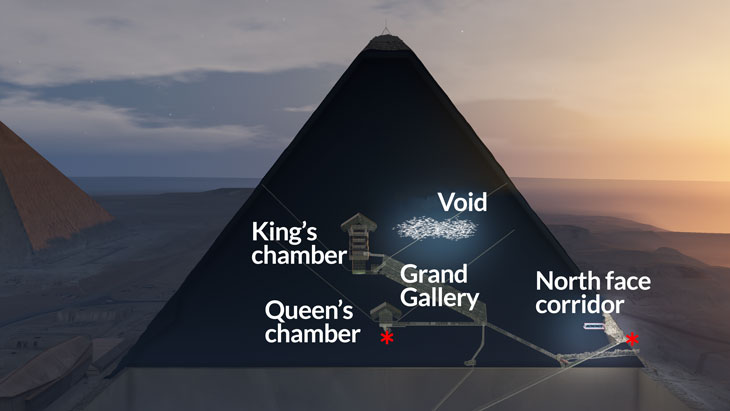Alien stuff has actually been able to help now, in the form of muons, by-products of cosmic rays that are related to but heavier than electrons and which most often reflect off of stone but can sometimes be absorbed. Using cosmic-ray muon radiography, a new study showed how researchers were able to non-invasively discover a previously unknown large room above the Grand Gallery. Its cross-section is similar to the Grand Gallery, so it is at least 90 feet long.
It has been confirmed using three different muon detection technologies and three independent analyses. They gave the room the unimpressive name ScanPyramids Big Void, but better names are for archaeologists to work out. The real story is that this is the first major structure found since the 19th century, and physics did it.

Credit: ScanPyramids collaboration
High-energy cosmic rays are constantly pelting us but they are usually deflected by thick rock. Nearly all muons won't be able to penetrate anything the size of a pyramid, they will instead be reflected, so one experiment used a "nuclear emission" film, which left silver streaks as the muons bounced. Using inference, they learned which directions the muons came from...and they discovered some were coming from inside the Great Pyramid itself. That means they were trace particles being reflected from a place inside no one knew was there.
That's where the other detectors come in. We always tell you not to accept a single study as fact - by now, every food and chemical has been in a WebMD article causing or preventing cancer based on a single study - so the researchers got other detectors to help. Inside the Queens Chamber below, they used scintillator hodoscopes, which can quickly detect passing charged particles and convert the readings into electrical signals. Outside at the base of Khufu’s Pyramid they placed micro-pattern gas detectors, which are more accurate. This allowed them to not only confirm the void was real but "triangulate" on its shape.
Citation: Kunihiro Morishima, Mitsuaki Kuno, Akira Nishio, Nobuko Kitagawa, Yuta Manabe, Masaki Moto, Fumihiko Takasaki, Hirofumi Fujii, Kotaro Satoh, Hideyo Kodama, Kohei Hayashi, Shigeru Odaka, Sébastien Procureur, David Attié, Simon Bouteille, Denis Calvet, Christopher Filosa, Patrick Magnier, Irakli Mandjavidze, Marc Riallot, Benoit Marini, Pierre Gable, Yoshikatsu Date, Makiko Sugiura, Yasser Elshayeb et al. 'Discovery of a big void in Khufu’s Pyramid by observation of cosmic-ray muons', Nature 02 November 2017 doi:10.1038/nature24647





Comments